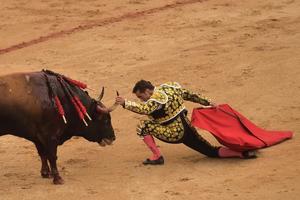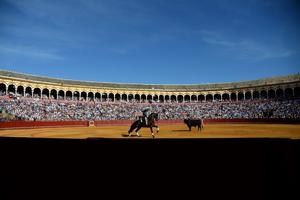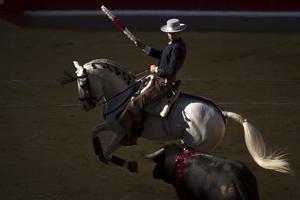 Spanish rejoneador (mounted bullfighter) Andy Cartagena brandishes a banderilla over a bull during the Corpus bullfight festival at the Granada bullring on June 18, 2017. (JORGE GUERRERO / AFP)
Spanish rejoneador (mounted bullfighter) Andy Cartagena brandishes a banderilla over a bull during the Corpus bullfight festival at the Granada bullring on June 18, 2017. (JORGE GUERRERO / AFP)
Usually at this time of year Madrid’s Las Ventas bullring is packed as matadors take on lethal half-tonne bulls in daily fights during the annual San Isidro festival.
The shut-down could deal a fatal blow to a controversial spectacle which poet Federico Garcia Lorca once called “the last serious thing”
But plazas across Spain are empty this season as the coronavirus epidemic has kept matadors and fans alike stuck in their homes for weeks on end.
ALSO READ: Spain reports new jump in infections as lockdown eases
Major festivals such as San Isidro, Sevilla’s April Fair, and Pamplona’s San Fermin in July have been cancelled and bulls have been sent from ranches straight to the slaughterhouse.
The shut-down could deal a fatal blow to a controversial spectacle which poet Federico Garcia Lorca once called “the last serious thing”.
Traditionally an emblematic part of Spanish culture, it has struggled for survival in recent decades.
 Spanish bullfighter El Fandi challenges a Fuente Ymbro's fighting bull at the San Fermin Festival, in Pamplona, northern Spain on July 10, 2017. (ALVARO BARRIENTOS / AP)
Spanish bullfighter El Fandi challenges a Fuente Ymbro's fighting bull at the San Fermin Festival, in Pamplona, northern Spain on July 10, 2017. (ALVARO BARRIENTOS / AP)
Although the big festivals still draw crowds, public interest in bullfighting has dwindled considerably.
Local governments have cut funding for fiestas, left-wing politicians oppose it, and a highly vocal anti-bullfight movement has grabbed headlines.
Some cities and regions, notably Catalonia, already prohibit bullfights, or “corridas”.
Although Spain has started to ease its coronavirus lockdown, it is not clear if any corridas will now take place before the end of the season in October.
ALSO READ: Spaniards enjoy flowers and haircuts as coronavirus lockdown eases
“The worst-case scenario for us would be not to have bullfights in the whole year. That would be dramatic,” bull breeder Victorino Martin told Reuters.
“Just imagine. We already haven’t had any income because of the winter stoppage, imagine one more year like this.”
The industry also supports thousands of jobs, from the matadors and their teams to ranch-hands and bullring staff. They are also under threat now.
 Spanish rejoneador Diego Ventura performs during a bullfight at the Real Maestranza bullring in Sevilla on May 8, 2019. (CRISTINA QUICLER / AFP)
Spanish rejoneador Diego Ventura performs during a bullfight at the Real Maestranza bullring in Sevilla on May 8, 2019. (CRISTINA QUICLER / AFP)
GOOD NEWS FOR ANTIS
For anti-bullfight activists, the corrida’s plight is to be welcomed.
“It has been good news, one of the few good news brought by this pandemic,” said Aida Gascon of AnimaNaturalis.
“Not only because of all the bulls that are not going to be tortured to death - although we know they are going to die anyway as they will be sent to the slaughterhouse. Nobody is going to benefit from that torture show.”
Activists have staged regular demonstrations outside plazas - sometimes even daubing themselves with fake blood and lying down naked on the ground. For them, it is a cruel and bloody spectacle which has no place in modern Spain.
CULTURAL TRADITION
The Union of Breeders estimates the industry’s losses could exceed 77 million euros if the season is written off.
 Spanish rejoneador Sergio Galan, rides his horse as the bull approaches during the Corpus bullfighting festival at the Monumental de Frascuelo bullring in Granada on June 22, 2019. (JORGE GUERRERO / AFP)
Spanish rejoneador Sergio Galan, rides his horse as the bull approaches during the Corpus bullfighting festival at the Monumental de Frascuelo bullring in Granada on June 22, 2019. (JORGE GUERRERO / AFP)
Ranchers have already shipped hundreds of bulls to the slaughterhouses, where they fetch about 500 euros (US$541) each as butcher’s meat. The cost of raising a fighting bull is about 5,000 euros, which is only viable if the events take place.
“Four or five thousand fighting bulls will go to the slaughterhouse this year without being fought and without giving us the revenue for which the brave bull is raised,” said Andres Romero, a rejoneador who fights the bulls mounted on a highly-trained horse.
READ MORE: Spaniards get outside to exercise after 49 days of lockdown
Supporters consider the bullfight an art form, not a sport.
The bulls are specially bred for the corrida, raised on ranches in the countryside before being shipped to the ring at the age of four or five. Their death at the hands of matador is the climax of the ritual - only rarely is one spared.
“We devote all possible resources to the animals since they are born until they die so they subsist and have a good life,” Romero said.


